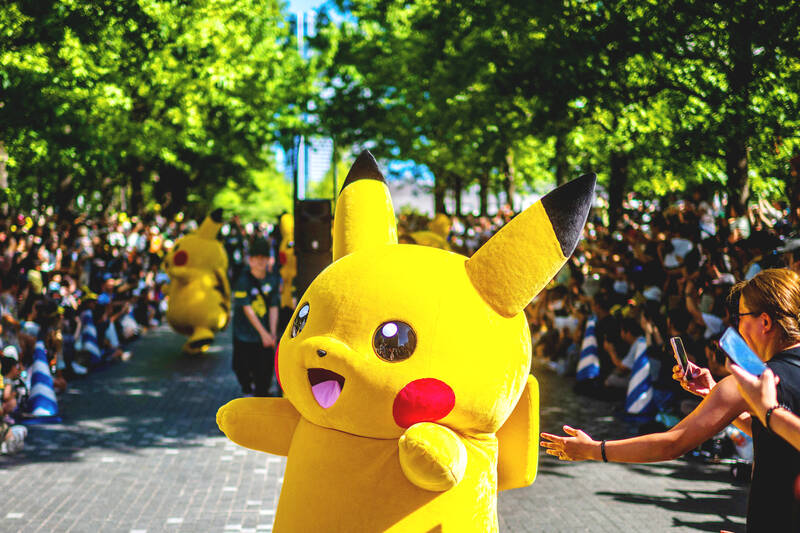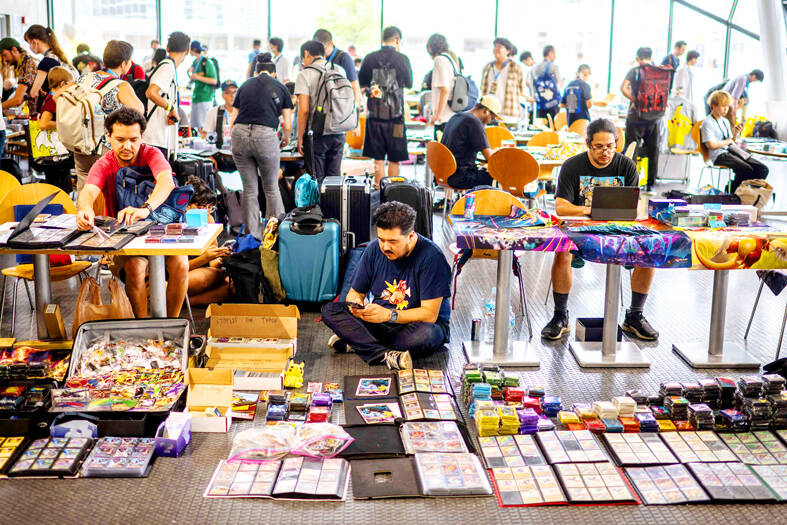Dressed up and ready for battle, about 10,000 Pokemon fans have descended on Yokohama in Japan this weekend, looking for fun, but also collector’s item cards potentially worth serious money.
Since the launch of Pokemon cards in 1996 following the hit computer game of the same name — meaning “pocket monsters” — an astounding 53 billion cards have been printed.
Almost 30 years on, the card game remains hugely popular as contestants take each other on with cards representing the monsters and their different attributes.

Photo: AFP
The Pokemon World Championships are being held in Japan for the first time this weekend. The world’s best players of the video and the card game are to battle it out for cash prizes at an event attended by thousands.
“I have been playing since I was a kid,” Ajay Sridhar, 33, who traveled halfway around the world from New York to attend with his cards.
“It’s just the competition, it’s the community... A lot of my oldest friends I’ve met through Pokemon,” he said, explaining why he was hooked.

Photo: AFP
“It’s kind of like chess, where if you didn’t play chess and you were watching a high-level chess match, you wouldn’t know what was going on, but once you get to a certain skill level, there is a lot of depth and complexity to it,” said Gilbert McLaughlin, 27, from Scotland.
Ranging from Pikachu to Jigglypuff to the jackal-headed Lucario, there are now more than 1,000 different Pokemon characters, with new “generations” released every few years.
While they have always been swapped and collected, the value of the cards has exploded in the past few years, not just among fans of the game, but also among investors with little or no past interest.
Factors determining value include the cards’ rareness, the character (Mew, Mewtwo, Pikachu and Charizard tend to be more valuable) and the artist, who is credited on the card.
Web sites have sprung up dedicated to helping people understand the dizzying array of different cards and their myriad markings, complete with charts showing their value over time.
The most expensive ever sold was in 2021 when US YouTuber Logan Paul paid — in a Dubai hotel room to a “mystery” seller — US$5.28 million for a supposedly unique, mint-condition “PSA Grade 10 Pikachu.”
The next year, Logan, 28, wore the card — inside a protective plastic case attached to a gold chain — around his neck at a WWE wrestling event in Texas.
Hiroshi Goto is an expert in Pokemon cards who has written a book with advice on how to make money from them.
He said that when he ran a shop selling the cards in the 2000s, his customers were mostly “schoolkids with their dads taking part in tournaments together.”
Yet since the 20th anniversary in 2016, “the perception of cards evolved into being not just toys for children, but also items appreciated by adults, collector’s items with a tangible value,” Goto said.
Demand is such that the Pokemon Co has had to increase production.
In Japan and the US there have been instances of physical fights, including one outside a shop in the Japanese city of Osaka last month that went viral on social media.
There have been cases of shops selling Pokemon cards being broken into in normally low-crime Japan in the past few months.
The gold-rush has also sparked a boom in fake cards. Paul, for instance, paid US$3.75 million in 2021 for a “sealed & authenticated” box of first-edition booster packs that turned out to contain “G.I. Joe” cards instead, he said in one of his videos.
On the sidelines in Yokohama, collectors were busy swapping and selling their cards, including Jeffrey Ng, happy after buying 10 cards for US$1,700. He now hopes to sell them for a profit.
“Conventions like this one are a good place to meet other collectors,” he said.
All cards are painstakingly conceived and designed in the same place, the Tokyo offices of Creatures Inc, which along with Nintendo and Game Freak own the Pokemon Co.
Creatures executive Atsushi Nagashima said while the firm was “very happy” about the success of the cards, “that doesn’t change how we do our job.”
Creatures employs 18 testers who spend their working days playing Pokemon to make sure that the new cards fit harmoniously with the vast number of existing ones.
“[But] we never hire people from competitions,” said Kohei Kobayashi, another manager at Creatures. “We want to leave the good players where they are, there where they shine.”

Taiwan Semiconductor Manufacturing Co (TSMC, 台積電) yesterday said that its investment plan in Arizona is going according to schedule, following a local media report claiming that the company is planning to break ground on its third wafer fab in the US in June. In a statement, TSMC said it does not comment on market speculation, but that its investments in Arizona are proceeding well. TSMC is investing more than US$65 billion in Arizona to build three advanced wafer fabs. The first one has started production using the 4-nanometer (nm) process, while the second one would start mass production using the

When an apartment comes up for rent in Germany’s big cities, hundreds of prospective tenants often queue down the street to view it, but the acute shortage of affordable housing is getting scant attention ahead of today’s snap general election. “Housing is one of the main problems for people, but nobody talks about it, nobody takes it seriously,” said Andreas Ibel, president of Build Europe, an association representing housing developers. Migration and the sluggish economy top the list of voters’ concerns, but analysts say housing policy fails to break through as returns on investment take time to register, making the

‘SILVER LINING’: Although the news caused TSMC to fall on the local market, an analyst said that as tariffs are not set to go into effect until April, there is still time for negotiations US President Donald Trump on Tuesday said that he would likely impose tariffs on semiconductor, automobile and pharmaceutical imports of about 25 percent, with an announcement coming as soon as April 2 in a move that would represent a dramatic widening of the US leader’s trade war. “I probably will tell you that on April 2, but it’ll be in the neighborhood of 25 percent,” Trump told reporters at his Mar-a-Lago club when asked about his plan for auto tariffs. Asked about similar levies on pharmaceutical drugs and semiconductors, the president said that “it’ll be 25 percent and higher, and it’ll

CHIP BOOM: Revenue for the semiconductor industry is set to reach US$1 trillion by 2032, opening up opportunities for the chip pacakging and testing company, it said ASE Technology Holding Co (日月光投控), the world’s largest provider of outsourced semiconductor assembly and test (OSAT) services, yesterday launched a new advanced manufacturing facility in Penang, Malaysia, aiming to meet growing demand for emerging technologies such as generative artificial intelligence (AI) applications. The US$300 million facility is a critical step in expanding ASE’s global footprint, offering an alternative for customers from the US, Europe, Japan, South Korea and China to assemble and test chips outside of Taiwan amid efforts to diversify supply chains. The plant, the company’s fifth in Malaysia, is part of a strategic expansion plan that would more than triple